Portfolio





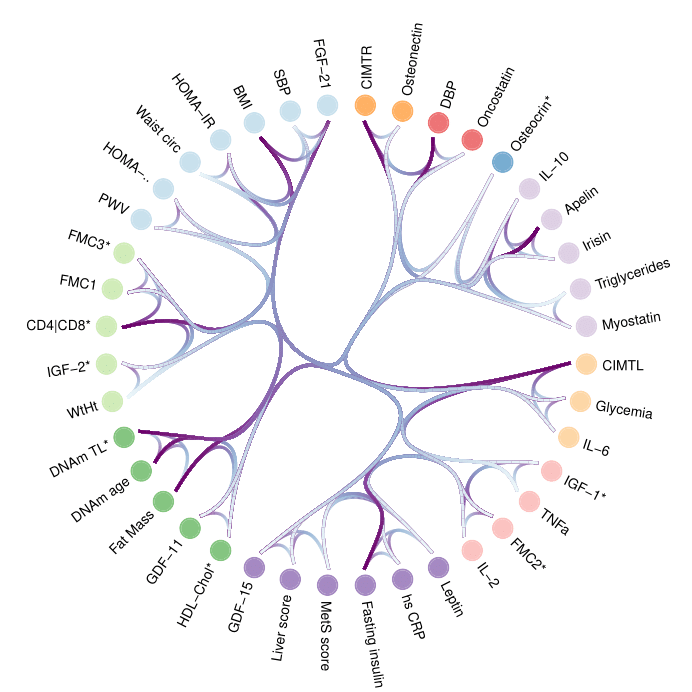

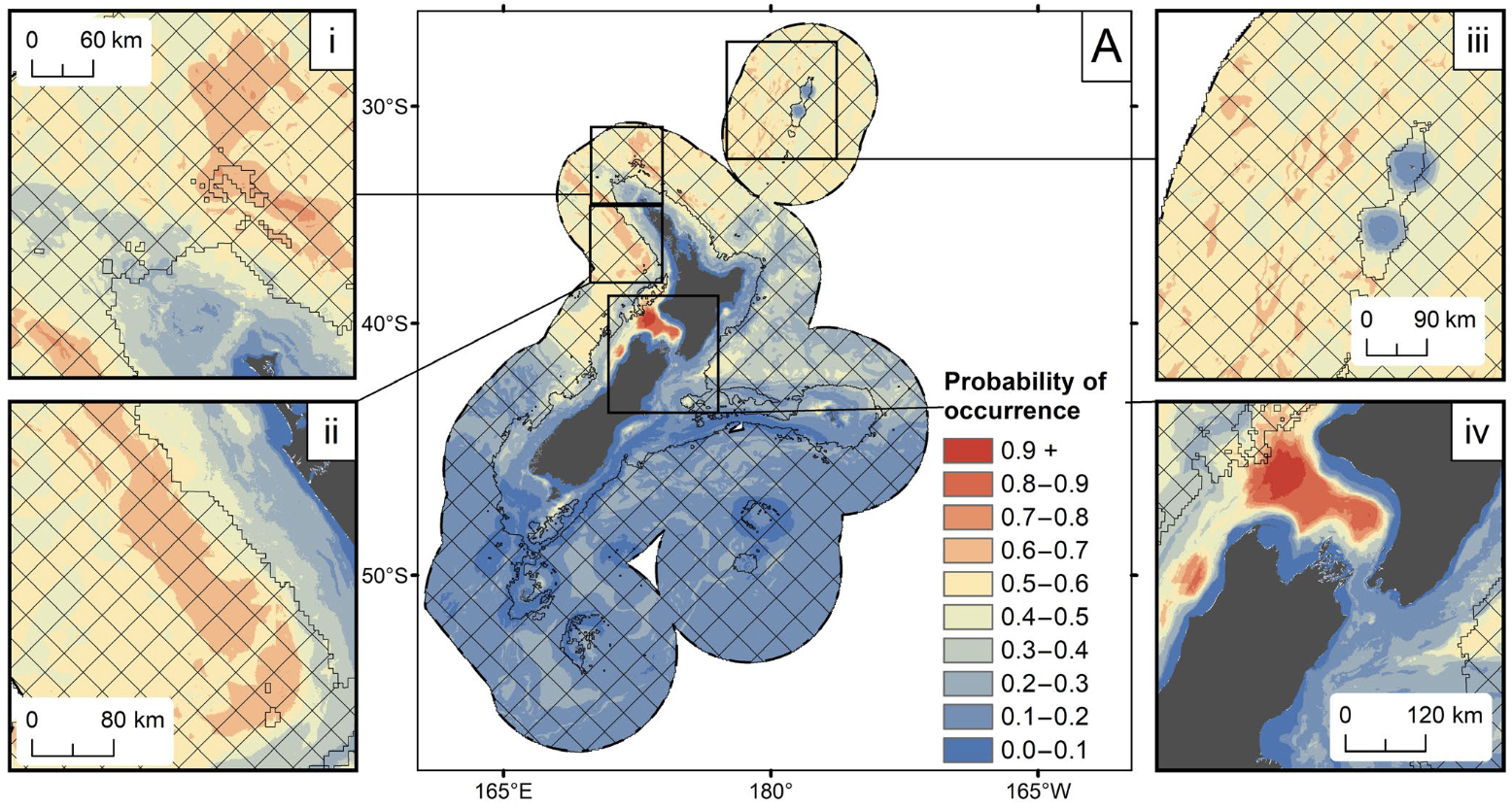
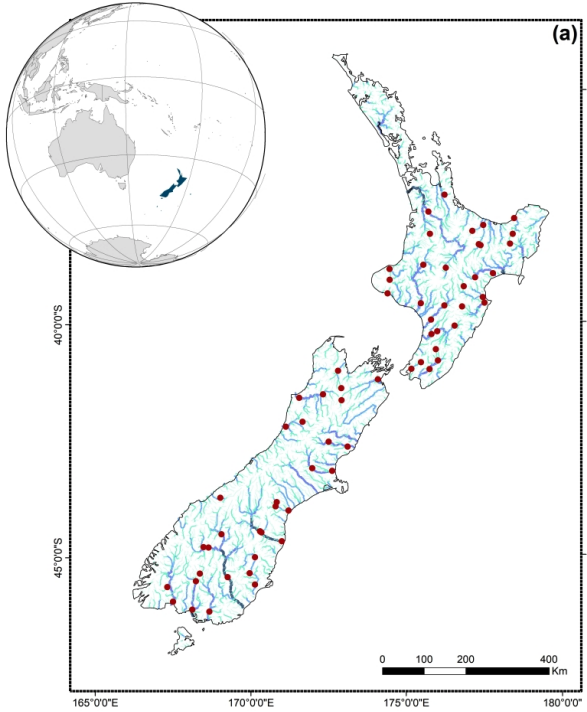

I designed and developed a data visualization dashboard for Citizens for Europe to analyze the largest European survey on social discrimination. Built using Shiny, the dashboard enables the creation of 14 different chart types, including bar plots, stacked bar plots, circle bar charts, upset charts, bubble charts, dumbbell charts, and Likert scale charts. This comprehensive tool enables the visualization of all survey responses, providing researchers with flexible ways to explore and present the data.
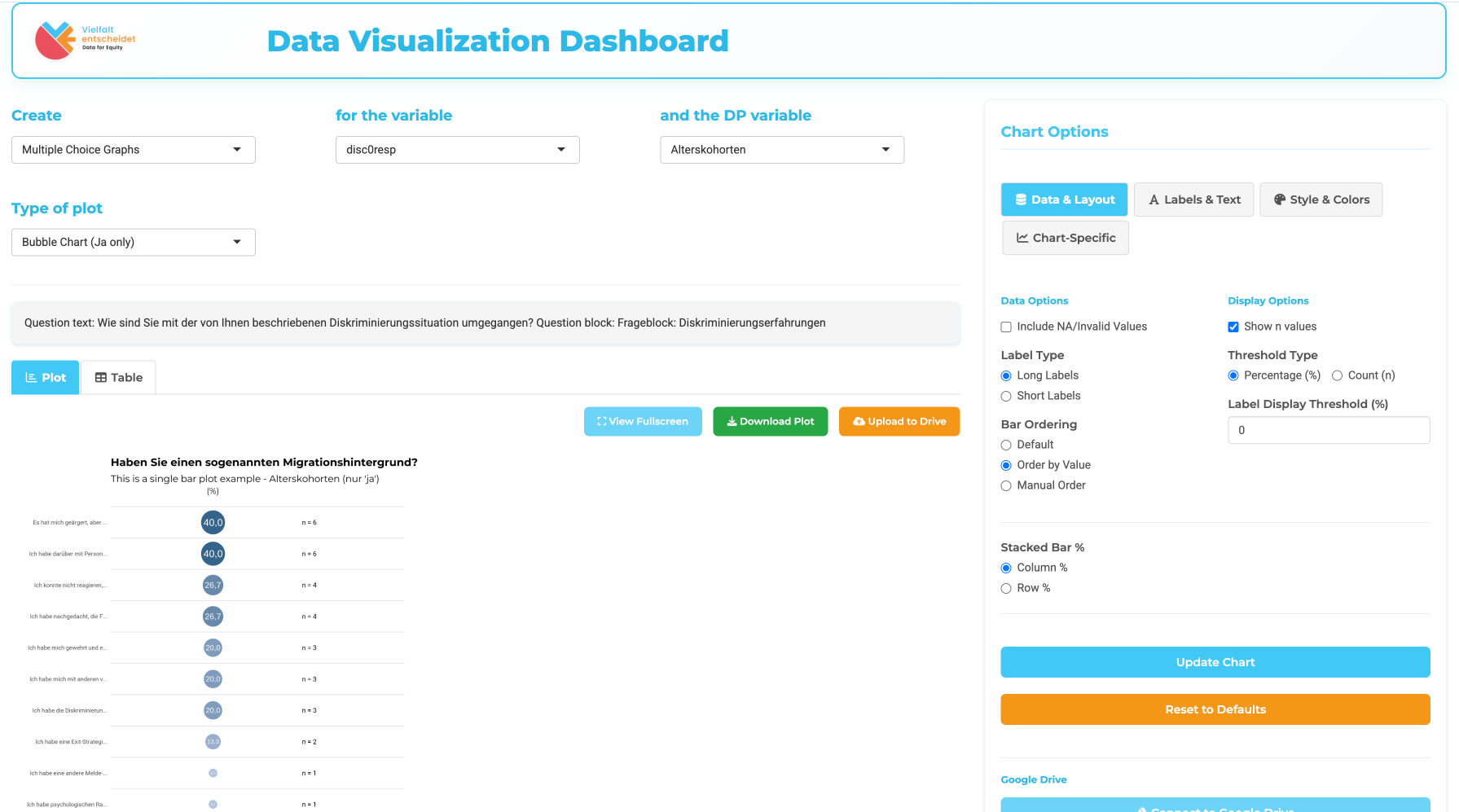
All charts are fully customizable through the app, with options to modify data and layout, labels and text, styles and colors, and chart-specific settings. Users can download the resulting visualizations as high-resolution PNG files or upload them directly to Google Drive. The app also generates corresponding data tables, which are available for download in publication-ready PNG format.

I was hired by Dr. Muriel Gros-Balthazard (Institute for Research and Development) to design and develop network visualizations of relationships between populations of trees spanning two continents. The work included creating static and interactive network charts of first and second degree relationships among individual trees or groups of clones. These results being under preparation for publication, they are currently confidential.

I was hired by Dr. Catalina Pimiento from the University of Zurich to compile and analyze global fishing effort datasets for a research project.
For this, I used Global Fishing Watch's latest datasets of fishing hours from Automatic Identification System (AIS) detections and fishing vessel detections from Sentinel-1 Synthetic Aperture Radar (SAR) imagery processing. These databases include dozens to hundreds of millions of records and are the best datasets for estimating fishing effort globally.
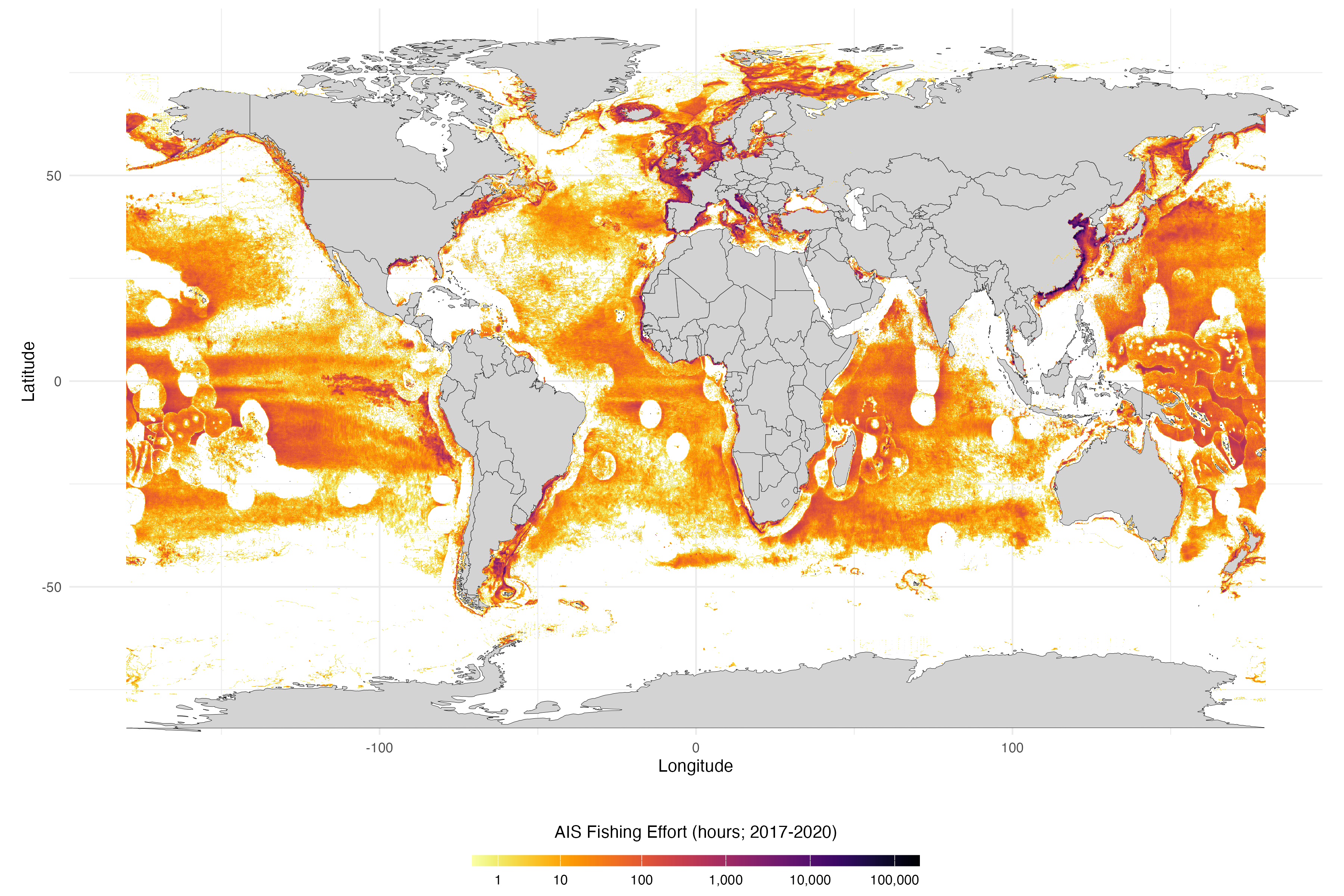

However, while AIS-based datasets offer unique information on global fishing effort, in some areas of the world (such as the Coral Triangle or the Caribbean Sea), fishing vessels do not broadcast AIS information. Nonetheless, fishing activity is detected in these regions through satellite imagery processing. To convert fishing vessel detections into estimated fishing hours in areas with only SAR detections, I built a machine learning-based predictive model (using random forest modeling) to predict fishing hours in these regions. The model included more than 150,000 records as training data and environmental predictors, such as the distance to ports, to improve performance. I also performed spatially blocked cross-validation and prediction to overcome spatial autocorrelation. As a result, my model explained 80% of the variation in fishing hours, and I was able to confidently predict fishing hours in 60,000 ocean grid cells.

In a second step, I used the same approach to predict estimated fishing hours in every ocean grid cell. I built a random forest model of fishing hours according to a wide range of environmental descriptors, including bathymetry, distance to ports, and marine protected area locations. This generated the map of estimated fishing hours in every ocean cell of the world, with the model explaining more than 75% of the variation in fishing hours.

I led and published an article in Marine Policy with 45 co-authors from Academia, Governments and NGOs under the supervision of Dr. Rima Jabado, the Chair of the IUCN SSC Shark Specialist Group. The article is titled: "Shortfalls in the protection of Important Shark and Ray Areas undermine shark conservation efforts in the Central and South American Pacific".

The project consisted of (i) assessing trends in Marine Protected Area (MPA) expansion and extent across the 12 nations of the region; (ii) quantifying the spatial overlap between MPAs and Important Shark and Ray Areas (ISRAs); and (iii) evaluating the effectiveness of the current MPA governance structure at protecting sharks and their critical habitat. We did this by utilising a combination of text analyses, statistical modelling (GLMM, PCA, Clustering) and GIS tools (sf, ArcGis).

There has been a recent rapid increase in the establishment of MPAs with 90 % of current MPAs in the region designated since 2010. Yet, El Salvador, Guatemala, Peru, and Honduras still protect less than 10 % of their waters. We find that ISRAs overlap with all MPAs by only 15.6 % and with no-take MPAs by 7.3 %. Of 182 MPAs identified, 41.8 % do not have a management plan, comprising 39.8 % of the total MPA extent. Mexico, Costa Rica, and Colombia have relatively strong governance frameworks in place and, along with Panama, Honduras, and Ecuador, represent the highest overlap between MPAs and ISRAs. However, the contribution of the remaining six countries to shark protection via MPAs is low based on limited spatial overlap with ISRAs (less than 2 % each).

As countries mobilise to meet the 30×30 target, we propose considering ISRAs as a key component of spatial planning when designing new MPAs, designating existing partially protected areas as no-take zones, or reshaping the boundaries of existing MPAs.
I was a postdoctoral researcher and scientific coordinator for the IUCN SSC Shark Specialist Group during a year, working on the Important Shark and Ray Areas project.
As I started the job, we tackled the Mediterranean and Black Seas Region and I was responsible for coordinating research in France, Monaco and Italy. The project resulted in the publication of 65 ISRAs, read the report here. A video of the workshop held in Thessaloniki, Greece is accessible below.
We later tackled the Western Indian Ocean Region and I was responsible for coordinating research in Seychelles, the Chagos Archipelago, La Réunion, Mauritius and the United Arab Emirates. The project resulted in the publication of 125 ISRAs, read the report here. A video of the workshop held in Durban, South Africa is accessible below.
I was hired by Prof. María Paulina Correa Burrows from the Universidad de Chile to apply Hierchical Edge Bundling (HEB) to cardiometabolic health markers for a study on the effects of obesity on the health of teenagers. I produced ten different HEBs, a quarto document and publication ready charts for this consultancy. The project is publicly accessible on my GitHub Repository

A group of researchers led by Dr. Catalina Pimiento and Prof. Fabien Leprieur, and including myself, investigated the functional diversity of sharks and rays in the world.
The group created a trait dataset of > 1000 species to assess elasmobranch functional diversity and compare it against previously studied facets (taxonomic and phylogenetic), to identify species- and spatial- conservation priorities. This consisted of using global spatial datasets of shark and ray distributions and macroecological statistical analyses (generalised modelling, ordination methods, spatial mapping methods etc.).

The spatial analyses showed that elasmobranch functional richness is concentrated along continental shelves and around oceanic islands, with 18 distinguishable hotspots. These hotspots only marginally overlap with those of other biodiversity facets, reflecting a distinct spatial fingerprint of functional diversity.
Elasmobranch biodiversity facets converge with fishing pressure along the coast of China, which emerged as a critical frontier in conservation. Meanwhile, several components of elasmobranch functional diversity fall in high seas and/or outside the global network of marine protected areas.
These results highlight acute vulnerability of the world's elasmobranchs' functional diversity and reveal global priorities for elasmobranch functional biodiversity previously overlooked.
GitHub Repository | Pimiento et al. 2024 (Nature communications)
A group of researchers led by Dr. Fabrice Stephenson and myself, and involving internationally renowned cetacean ecologists, such as Leigh G. Torres and Camille Albouy investigated the spatial distribution of cetacean biodiversity in New Zealand waters. This project led to three research papers published in Rank A journals.
The first publication involved modelling the spatial distribution of cetaceans in New Zealand. For this, we curated a national database of cetacean sightings at sea (>7000 sightings) and used Boosted Regression Tree and Relative Environmental Suitability modelling to predict the distribution of 30 species and species richness within New Zealand's EEZ. A report was also published and prepared for Fisheries New Zealand (Ministry for Primary Industries).

The second publication used the prioritisation software Zonation to identify cetacean richness hotspots for conservation management. We investigated how varying levels of uncertainty in predictions of the taxa' occurrence layers would affect our interpretation of cetacean hotspots.

In the third publication we modelled spatial patterns of taxonomic, functional, and phylogenetic diversity of cetaceans. We examined areas of congruence among hotspots of richness and uniqueness components of biodiversity and measured the contribution of species to biodiversity.

Stephenson et al. 2020 (Diversity and Distributions) | Stephenson et al. 2021 (Ecosphere) | Mouton et al. 2022 (Biological Conservation)
This project constituted the core of my PhD project. I designed and led studies on temporal changes in biodiversity under climate and land-use change using databases from New Zealand's national network monitoring programs. I collaborated with scientists during this research, mostly Assoc. Prof. Jonathan Tonkin and Dr. Mathieu Floury.

In the first publication, I assessed temporal changes in taxonomic and functional spatial beta-diversity of river macroinvertebrates and possible drivers of these changes using Hierarchical Generalised Additive Modelling. We observed long-term, mostly climate-induced, temporal trends towards taxonomic homogenization but functional differentiation among macroinvertebrate assemblages.

In the second publication I examined changes in population size and range shifts of species pools, and related these to taxonomy and functional traits. We found that increases in population and species range size were more prevalent than decreases in population and range size. Species shifted their ranges towards higher latitudes on average by 50 km per decade. Despite little to no relationship with taxonomy, we uncovered distinct relationships between functional traits and population trends and latitudinal species range shifts.
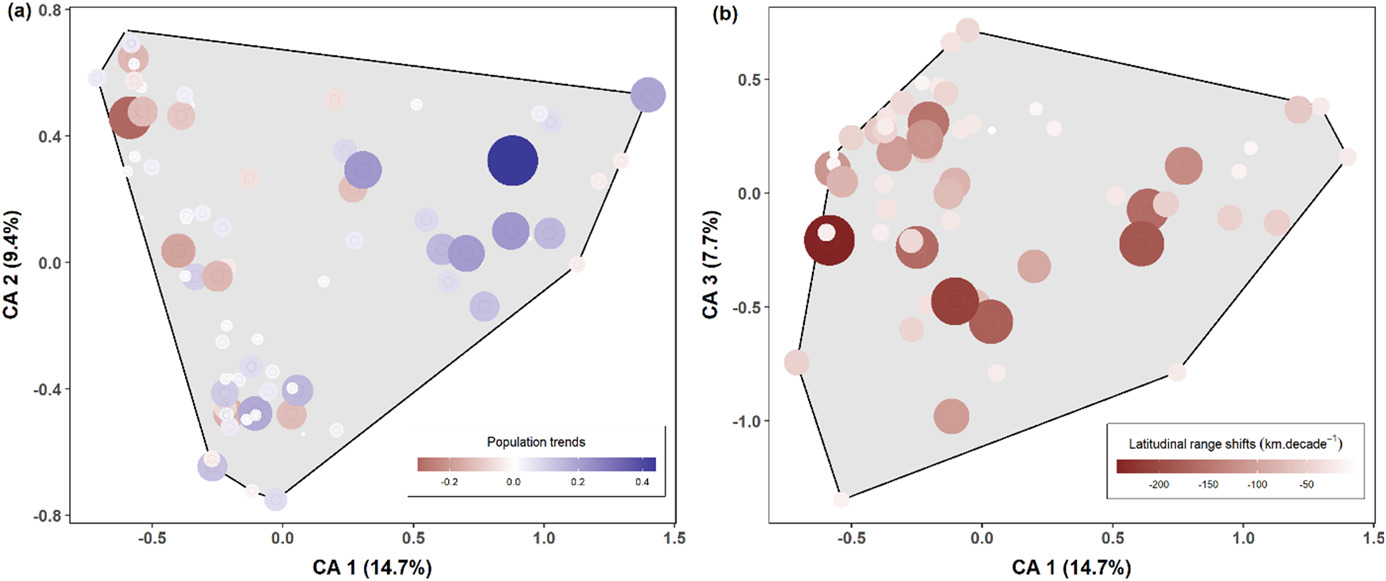
This work was also showcased in Issue 12 of the science magasine NatureVolve, page 32.
Mouton et al. 2020 (Global Change Biology) | Mouton et al. 2022 (Ecography) | NatureVolve (Issue 12)
This was my first project while working at the National Institute for Water and Atmospheric Reseach. It led to my first scientific publication. I compiled a database of native and non-native macrophyte abundance in Waikato Region (New Zealand) streams, a matrix of 11 functional traits and data on associated natural and human-driven processes.

I used a three-way ordination technic (RLQ analysis), multidimentional functional diversity indices and a model-averaging procedure to determine the functional response of macrophytes to anthropogenic disturbances. This demonstrated that stream reach-scale habitat disturbances were associated to a dominance of more productive species, equating to a greater abundance of non-native species.

These results suggest that the conservation and restoration of riparian vegetation that provides substantial shading and hydromorphologically diverse in-stream habitat, would have beneficial direct and indirect effects on ecosystem functioning, and contribute to the mitigation of land-use impacts.


